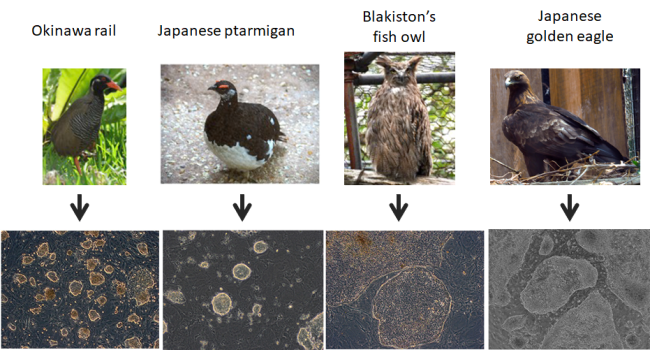Establishment of induced pluripotent stem cells from endangered avian species; Okinawa rail, Japanese ptarmigan, Blakiston’s fish owl, and Japanese golden eagle
Japan extends from north to south, resulting in a huge diversity of climate and environmental conditions. Various endemic species have evolved in Japan as a result of their ability to adapt to diverse environmental conditions. Thus, Japan is a hotspot of animal diversity a number of endemic species are already, or are becoming endangered, with the numbers increasing steadily in recent years, mainly due to human activities such as forest destruction and global warming. According to data from the Ministry of the Environment, Government of Japan, 1446 species are categorized as endangered (red-list categories Critically Endangered (CR), Endangered (EN), and Vulnerable (VU)). Notably, 98 avian species are categorized as endangered, including 24 critically endangered, 31 endangered, and 43 vulnerable species. Conservation of endangered species is essential for maintaining biological diversity, especially for the future generations.
Application of new technologies, such as induced pluripotent stem cells (iPSCs), may contribute to salvage the decreasing numbers of endangered animals and conservation of genetic resources. iPSCs express pluripotency markers through pluripotency-related genes, and differentiate into three germ layers in vivo and in vitro. We established novel iPSCs from three endangered avian species (Okinawa rail, Japanese ptarmigan, and Blakiston’s fish owl), using seven reprogramming factors (M3O, Sox2, Klf4, c-Myc, Nanog, Lin 28, and Klf2). iPSCs from these three endangered avian species displayed different cellular characteristics even though the same reprogramming factors were used. Japanese ptarmigan-derived iPSCs have biological characteristics different from those observed in other avian-derived iPSCs. Japanese ptarmigan iPSCs contribute to chimera formation in chick embryos. To the best of our knowledge, this is the first study to establish iPSCs from primary fibroblasts of the three endangered avian species. Our findings provide the first evidence of the potential value of iPSCs as a resource for conservation of endangered avian species. In addition to these three species, we also established Japanese golden eagle-derived iPSCs. All the four iPSCs derived from the endangered avian species can differentiate into various cells, such as neural-like cells and hepatocyte-like cells. These differentiated cells can be used to evaluate the risk of infectious diseases and pollution by these avian species. The convincing outcomes of our study indicate that the established iPSCs can contribute to conservation of these as well as other endangered avian species.
The research is published in the October 24, 2022 issue of Communications Biology.
Article Information
Title
Induced pluripotent stem cells of endangered avian species
Authors
Masafumi Katayama*, Tomokazu Fukuda*, Takehito Kaneko, Yuki Nakagawa, Atsushi Tajima, Mitsuru Naito, Hitomi Ohmaki, Daiji Endo, Makoto Asano, Takashi Nagamine, Yumiko Nakaya, Keisuke Saito, Yukiko Watanabe, Tetsuya Tani, Miho Inoue-Murayama, Nobuyoshi Nakajima, Manabu Onuma*
*: Corresponding author
Journal
Communications biology
DOI
10.1038/s42003-022-03964-y5
URL
https://doi.org/10.1038/s42003-022-03964-y
Expert Contact
Masafumi Katayama Ph.D.
National Institute for Environmental Studies
16-2 Onogawa, Tsukuba, Ibaraki 305-8506 Japan
katayama.masafumi (please append ‘@nies.go.jp’ to complete the email address)
Tomokazu Fukuda Ph.D.
Iwate University, Graduate School of Science and Engineering
Iwate University, Faculty of Science and Engineering, Laboratory of Cell Engineering and Molecular Genetics
4-3-5, Ueda, Morioka City, Iwate Prefecture, 020-8551, Japan
tomof009 (please append ‘@ iwate-u.ac.jp’ to complete the email address)
Manabu Onuma Ph.D., D.V.M.
National Institute for Environmental Studies
16-2 Onogawa, Tsukuba, Ibaraki 305-8506 Japan
monuma (please append ‘@nies.go.jp’ to complete the email address)
- What's New
- What's New 2025
- What's New 2024
- What's New 2023
- What's New 2022
- What's New 2021
- What's New 2020
- What's New 2019
- What's New 2018
- What's New 2017
- What's New 2016
- What's New 2015
- What's New 2014
- What's New 2013
- What's New 2012
- What's New 2011
- What's New 2010
- What's New 2009
- What's New 2008
- What's New 2007
- What's New 2006
- What's New 2005
- What's New 2004
- What's New 2003
- What's New 2002
- Event Information
- Visit NIES
